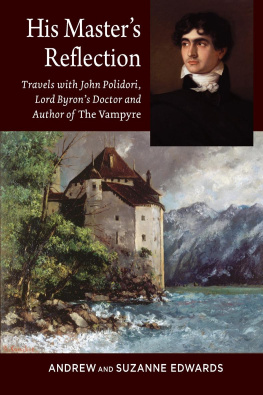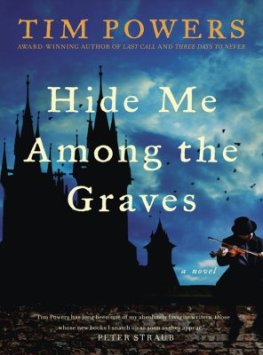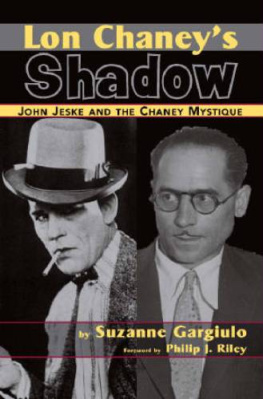Photo reproduction of a print after a portrait of Lord Byron by Thomas Phillips, anonymous, after Thomas Phillips, c. 1870, Rijksmuseum
His Masters
Reflection
Travels with John Polidori,
Lord Byrons Doctor and
Author of The Vampyre
ANDREW AND SUZANNE EDWARDS
Copyright Andrew Edwards and Suzanne Edwards, 2019.
Published in the Sussex Academic e-Library, 2018
SUSSEX ACADEMIC PRESS
PO Box 139, Eastbourne BN24 9BP, UK
Distributed worldwide by
Independent Publishers Group (IPG)
814 N. Franklin Street
Chicago, IL 60610, USA
ISBN 9781845199531 (Paperback)
ISBN 9781782845683 (EPub)
ISBN 9781782845690 (Kindle)
ISBN 9781782845706 (Pdf)
All rights reserved. Except for the quotation of short passages for the purposes of criticism and review, no part of this publication may be reproduced, stored in a retrieval system, or transmitted, in any form or by any means, electronic, mechanical, photocopying, recording or otherwise, without the prior permission of the publisher.
British Library Cataloguing in Publication Data
A CIP catalogue record for this book is available from the British Library.
This e-book text has been prepared for electronic viewing. Some features, including tables and figures, might not display as in the print version, due to electronic conversion limitations and/or copyright strictures.
Contents
The Illustrations
Map:Key locations in the travels of John Polidori
ONE
Starting OutThe High Road
TWO
The Low CountriesFlemish Faces
THREE
The RhineSeduced by Loreley
FOUR
SwitzerlandThe Summer of Creation
FIVE
ItalyThe Austrian Soldiers Hat
SIX
The ReturnDippels Acid
Bibliography
Index
The Illustrations
The cover illustrations are detailed on the back cover.
Frontispiece: Photo reproduction of a print after a portrait of Lord Byron by Thomas Phillips, c. 1870, (anonymous, Rijksmuseum)
Former Polidori residence, 38 Great Pulteney Street, London, (S. Edwards).
St Marys Church, Dover, (A. Edwards).
Edinburgh Rooftops, (Lino9999, Pixabay).
The anatomical lesson of Nicolaes Tulp, Johannes Pieter de Frey, after Rembrandt van Rijn, 1798, (Rijksmuseum).
The Dijver, Bruges, (S. Edwards).
The Ghent Altarpiece by the van Eyck Brothers in St Bavo Cathedral in Ghent, Pierre Franois De Noter, 1829, (Rijksmuseum).
Antwerp Cathedral, (Juulz Grand, Pixabay).
Battlefield of Waterloo, H. Grard (possibly), 1842, (Rijksmuseum).
Drachenfels near Knigswinter, (Ricco Stange, Pixabay).
Castle Frankenstein, Burg Frankenstein, (Lapping, Pixabay).
The Rhine at Bingen, (A. Edwards).
The tomb of General Lahmberg, Mainz Cathedral, (S. Edwards).
The Villa Diodati, Cologny, (A. Edwards).
Plaque commemorating Byron on the wall of the Villa Diodati, Cologny, (S. Edwards).
Stone commemorating the 100 year anniversary of Byrons death, Le Pr Byron, Cologny, (S. Edwards).
View of the Castle of Chillon, Jan Gerard Waldorp, after Michel Vincent Brandoin, 1792, (Rijksmuseum).
The Stockalper Palace, Brig, (S. Edwards).
The Semplon Pass, (R. Gerber, Pixabay).
Statue of Galvani, Piazza Luigi Galvani, Bologna, (S. Edwards).
The Lungarno, Pisa, (A. Edwards).
Costessey Hall c. 1850, Costessey, (photographer unknown, Wikipedia).
Costessey Hall outbuildings in ruin, (A. Edwards).
Cover of the book, Costumes of Italy, Switzerland and France, (A. Edwards from the British Library collection).
The Hardy Tree, St Pancras Old Church, London, (A. Edwards).
The author and publisher gratefully acknowledge permission to reproduce copyright material as detailed in the above list. The publishers apologize for any errors or omissions in the above list and would be grateful to be notified of any corrections that should be incorporated in the next edition or reprint of this book.
Key locations in the travels of John Polidori
This book is dedicated to
Youth &
With heartfelt thanks to Franklin Bishop
CHAPTER ONE
Starting Out
The High Road
The first effects were felt as far away as Borneo and Sulawesi with ash beginning to settle on the palms; a portentous precursor to the devastation that would follow. On the island of Sumbawa, Mount Tambora had finally given vent to the unsustainable pressure of magma hidden within its cavernous chambers. Thousands lost their lives in the immediate aftermath of the eruption whilst thousands more in the south-east Asian region would succumb to disease or starve as agricultural output withered to nothing.
Tamboras volcanic outburst in the April of 1815 was of such magnitude that the sheer volume of material hurled into the atmosphere inevitably found its way across continents, lingering in a malignant haze that turned day into night and the summer of 1816 into winter. European hearths were ablaze against the unworldly chill of the July darkness. Around a fireplace in Cologny, on the shores of Lake Geneva, five young friends who should have been strolling under the blanket of a warm alpine evening, were instead forced inside once more by the incessant rain.
Lord Byron stood by the fireside of his rented villa; inspired by the gloom, the poet turned to a book of German tales translated into the French they all understood. This Fantasmagoriana captivated his audience Claire Clairmont, his mistress, already enthralled by her lover, listened in restless awe, as the highly-strung Percy Bysshe Shelley, seated next to his future wife, Mary, became increasingly agitated. Byron then laid down a challenge that has passed into literary history: each of them was to write a ghost story.
Former Polidori residence, 38 Great Pulteney Street, London, S. Edwards
St Marys Church, Dover, A. Edwards
Edinburgh Rooftops, Lino9999, Pixabay
The anatomical lesson of Nicolaes Tulp, Johannes Pieter de Frey, after Rembrandt van Rijn, 1798, Rijksmuseum
On the following evening, the aristocrat continued his readings with Coleridges poem,

















